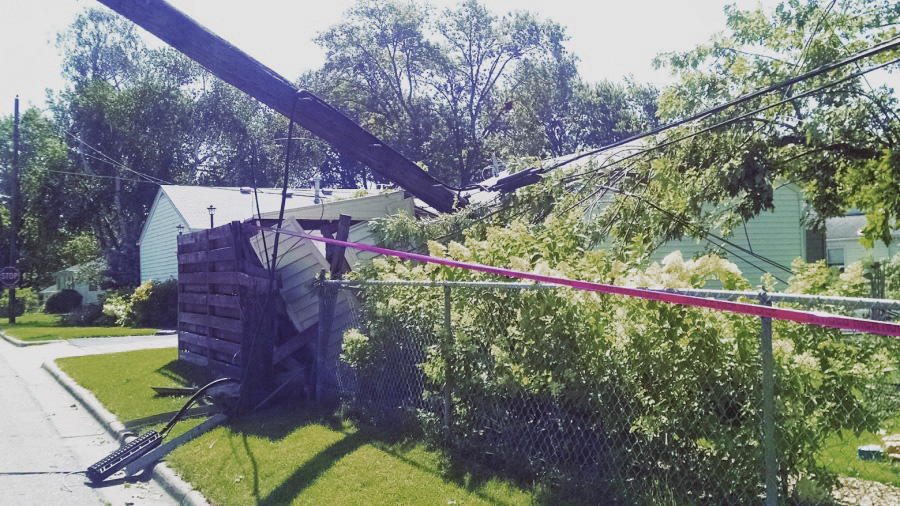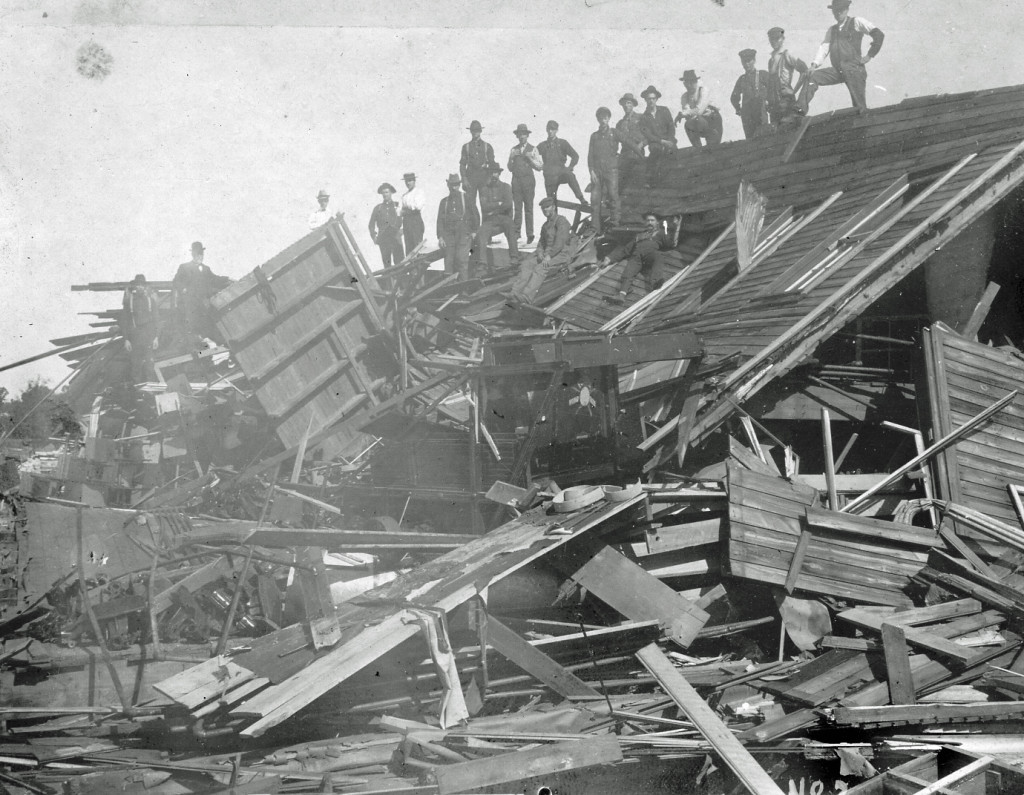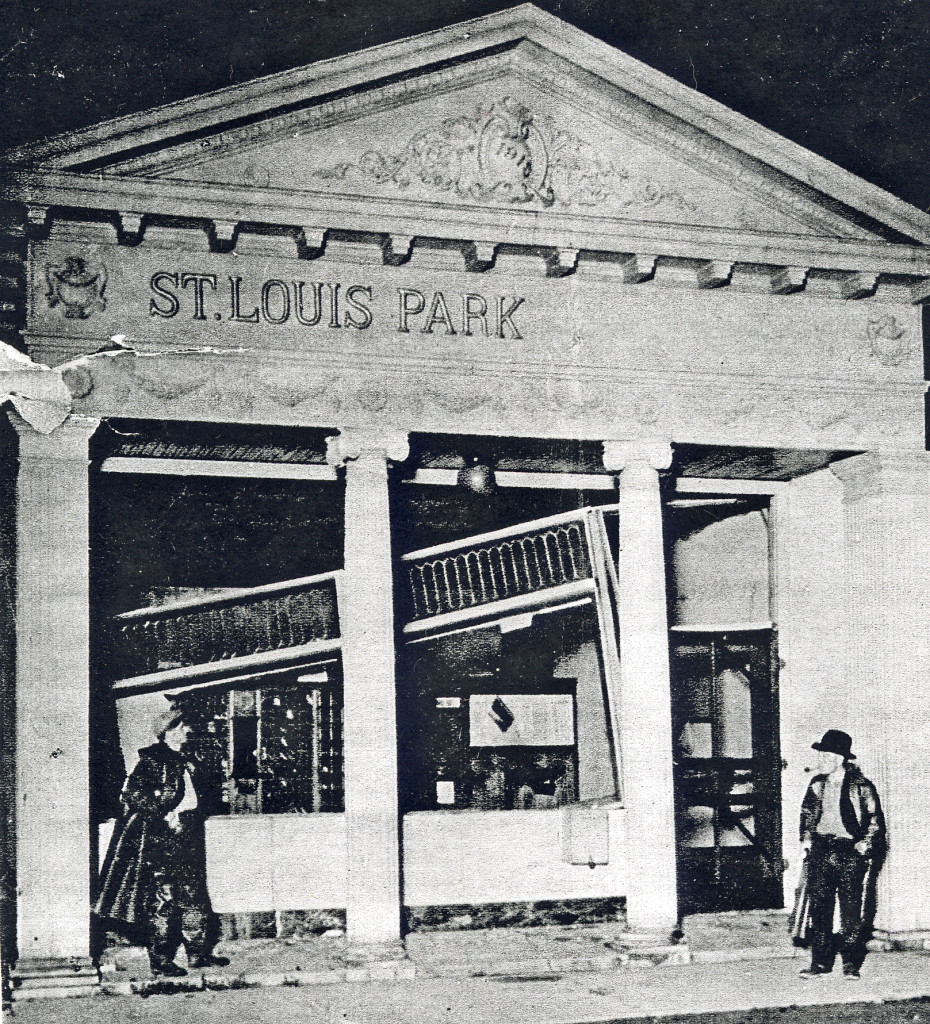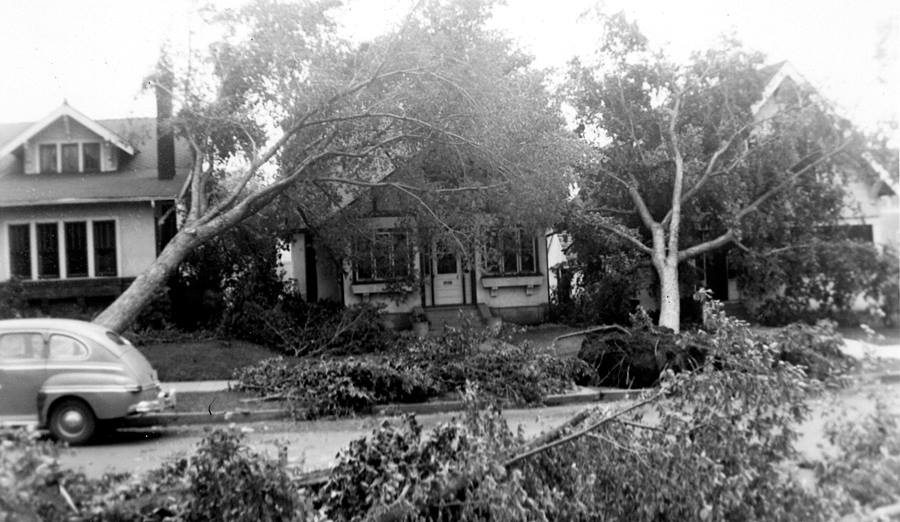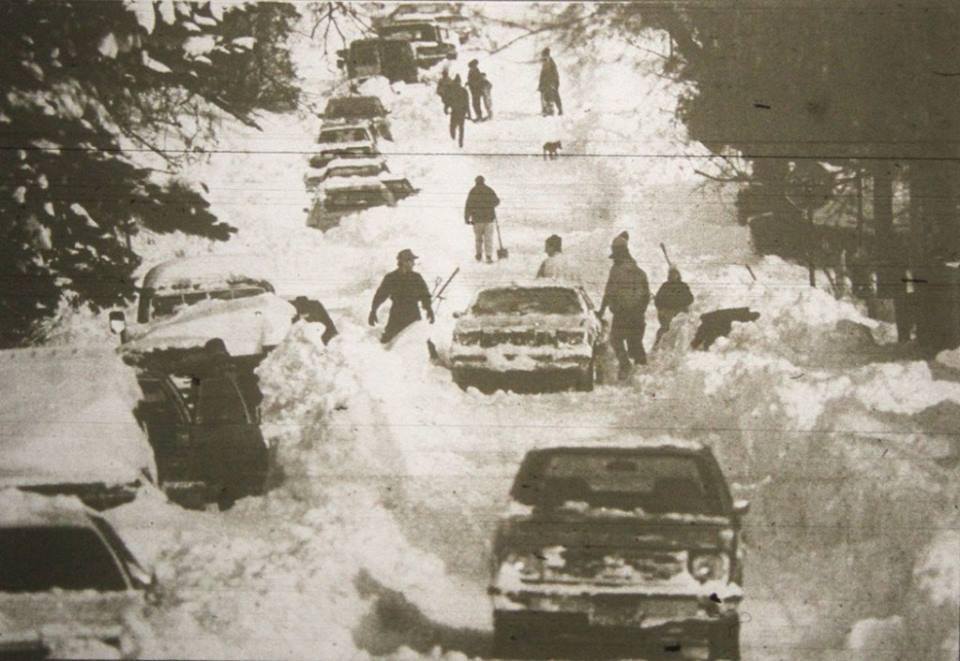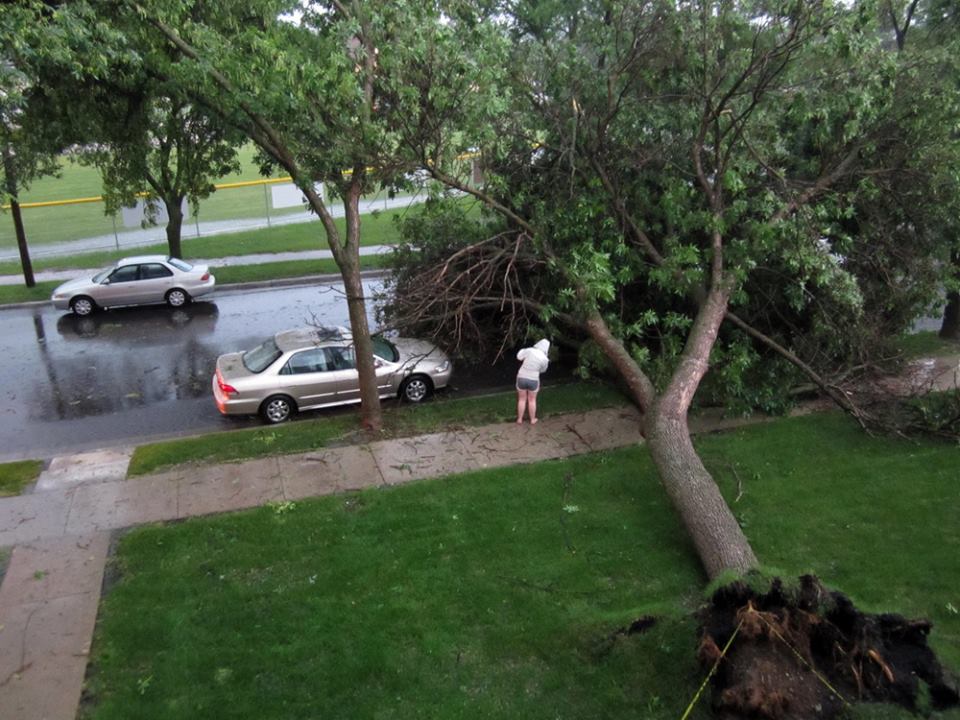The weather may be an interesting topic at the time, but the history of weather? Here are some highlights of the most unusual weather experienced by residents of St. Louis Park and the Twin Cities. We hope you will contact us if you have any weather-related stories to tell or photos to share.
1855-56 was a cold winter for new settlers to be out in temporary quarters. The cold wave started on December 22, 1855, and except for a few hours on January 1 and 2, 1856, the temperature at Fort Ripley was at or below zero for the next 20 days, with many afternoon readings at minus 10 to minus 20 degrees.
For the second year in a row, the winter of 1856-57 was exceptionally cold. At Fort Ripley temperatures were recorded at minus 50 degrees in February 1857. And it continued – that April was the coldest April ever in the Twin Cities.
On February 13-15, 1866, “Minnesota’s Great Blizzard” struck, raging for three days. Severe cold, as low at 30 below, followed. The storm struck at night when people were safe at home, limiting casualties. 20 ft. drifts buried barns. The decade was the coldest in all recorded Minnesota history.
On March 14-16, 1870, a blizzard hit Iowa and Minnesota, dumping up to 16 inches of snow. The term blizzard was reportedly coined by a newspaperman in Esterville, Iowa. It was a boxing term, meaning a volley of punches. Others claim it was derived from the German word “blitz.” The term gained official acceptance on December 8, 1876, when it was used in the Weather Bureau publication Monthly Weather Review.
On January 7-10, 1873, a three-day blizzard hit Minnesota and killed 70 people. Hundreds of cattle were lost, and trains were stuck for days in the high drifts.
THE GRASSHOPPER PLAGUE
Not exactly the weather, but from 1873 to 1877 a Grasshopper Plague invaded Midwestern farmland, particularly in southwestern Minnesota. Swarms of grasshoppers (aka Rocky Mountain locusts) landed, destroyed crops, and laid eggs for next year. Finally, in 1877, after yet another crop was devastated, the newly-hatched young did not move on as usual but swarmed in the air for weeks until one day they just flew away. Many ascribed it to the official day of prayer held on April 26, 1877.
Hennepin County suffered slight grasshopper damage only in the year 1874; southwestern Minn. crops were destroyed in 1875. In two of the grasshopper years, they came alarming close to the City, but there doesn’t seem to have been any reports of grasshoppers in St. Louis Park, which may be because local farmers specialized in truck farming, which wasn’t as vulnerable as grains and cereals.
In a biography of T.B. Walker, it is said that after he made a personal inspection of the area, he speculated that a late crop of turnips and buckwheat would be possible. He purchased all the seed he could find in the Twin Cities and Chicago and “personally distributed” it to the farmers. The crop was successful and helped alleviate the suffering of the people and animals. Although farmers had pleaded with Governor Pillsbury for monetary relief, he refused, calling the phenomenon an act of God and unwilling to set a precedent. (the “Pillsbury no-dough boy?”) For the complete story of the grasshopper plague, see Harvest of Grief, by Annette Atkins, 1984. There was another grasshopper plague in June 1932.
1886 saw the deadliest tornado in Minnesota history, striking St. Cloud and Sauk Rapids, killing 72 and injuring 213.
January 12-13, 1888 saw a sudden cold wave and blinding snow. Temperatures were down to 37 below. The day started out mild, but many children died when sent home from school early. In all, perhaps 200 died in Minnesota’s worst blizzard.
The disastrous hurricane that killed 6,000 people in Galveston made its way north, pouring 6.65 inches of rain on St. Paul, September 9-11, 1900.
THE 1904 TORNADO
On August 20, 1904, a tornado of such historic proportions that it was termed a cyclone started in South Dakota and killed 14 people. Winds were reported up to 180 miles per hour.
Three people were killed in Glencoe, and a St. Paul Globe article said that $100,000 damage was done in Waconia. The storm continued east and significant damage was done to both downtown Minneapolis and St. Paul. It then traveled to Stillwater. Click Here to see a video about the tornado.
St. Louis Park residents killed were:
- Albert Ohde, age 32. From the St. Paul Globe:
Albert Ohde met his death in a strange manner. He was the proprietor of a public house, and his living rooms were above the store. The the storm made its appearance Mr. Ohde and his family hurried to the cellar, and while here Mr. Ohde remembered that lighted lamps were burning in the upper stores of the building, and realizing the danger from fire he hastened upstairs for the purpose of extinguishing them. He never returned. A chimney fell through the roof carrying heavy timbers with it and when the storm was over neighbors who explored the ruins of his business place found the body under a pile of timbers. A ton or more weight was upon him and his body was badly crushed. But for his presence of mind it is almost certain that a conflagration would have followed the wreck of the hurricane.
- Anna Heyda, age 6. Again from the St. Paul Globe:
Her death was a most sensational incident. The heavy rainfall had kept the family indoors for some time, and when the threatening clouds assembled they took refuge in the cellar. The storm broke with most intense fury and the house was lifted from over the heads of the people who had taken refuge in the cellar. The house quivered from the force of the storm. “It is going to fall on us,” screamed the eight-year-old son of Mr. Heyda, and before his father could prevent him he darted from the cellar where the family was a prayers and fled out into the storm. He grasped a small tree and hung on. A minute later the house was lifted from its foundations and carried rods away, broken into fragments which were scattered over a large area. The instant the house was lifted from its foundations the wind swept the little Heyda girl from the cellar and carried her at least twenty yards across the street, and her body, mangled almost beyond recognition, was found a few moments later. The little boy was found clinched about the sapling. His muscles were rigid and for a time it was thought he was dead, but he was revived in a few moments and is now out of danger.
- son of Frank Hedger, age 6
Residents injured included:
- Charles Peterson, broken arm
- Frank Heyda, age 7, broken ribs
- Sophie Heyda, age 2, internal injuries
- Nels Nelson, head crushed
- Mrs. Nels Nelson, spine injury
- Julius Nygaard, shocked by lightning
- Rasmus Nelson, broken arm
- Frank Heyda, knocked unconscious, serious
- Babe Nelson, injured by falling furniture
Homes destroyed included those of
- Nels Nelson
- Robert Nelson
- Frankk Heyda
- Carl Sorenson
- Julius Nygaard
- Albert Ohde
T.B. Walker was said to be the owner of most of the 20 houses that were overturned. Damage was estimated at $25,000.
Factories damaged included:
- Minnesota Sugar Refining Company, sustaining damages of $25,000
- Sosstan Windsack Company, all buildings razed; damages of $25,000
Albert Ohde was one of three people killed. “They operated a store on the corner of 36th next to the railroad tracks. The family lived upstairs and he went to the basement to see that the windows were closed and the storm took that part of the building.” In 1918 it was reported that Ohde’s widow remarried and moved to California.
The 1904 tornado took the Marble works and left a small office built of wood upon a pile about 30 feet away. This was later used for a store house and later became the store Freelands now on” [3751 Alabama, built in 1918]
In the Park, the storm heavily damaged the Sugar Company, Malleable Iron Works, Fosston, Monitor, the Peavy and Great Western Elevators, and 20 houses.
On August 26 there was a meeting to organize a local relief committee to help those made destitute by the storm. Members of the committee were A.T. Masters, H.G. Freeman, C.B. Waddell, E.M. Trenkley, Dr. John Watson, Mrs. C. Rixon, and Mrs. Charles Hamilton, all prominent Park citizens. The citizens of Minneapolis proper were also urged to donate to a fund to help tornadoes in St. Louis Park and Waconia, with donations accepted at city drug stores.
On September 12, 1904, the Village Council appropriated $100 for the victims of the tornado Photo of storm damage below.
Union Congregational Church donated $50 to the 1906 California earthquake relief fund.
The winter of 1912-1913 was one of the coldest ever.
On June 23, 1914, a tornado hit the Park that was so powerful it was likened to a hurricane. Seventeen-year-old Esther Munson was killed. See the Hurricane of 1914.
That June of 1925 was setting a record for rain. By June 27, it had rained for 20 days, wreaking havoc on streetcars and power lines. Sand was washing onto streetcar tracks, forcing them to derail. Sewers backed up, basements flooded, and horses got stuck in the mud. The Minneapolis Tribune reported that the Como-Harriet streetcar line was blocked and 100 passengers were marooned in a little lake. Work cars trying to clear the tracks got stuck in many inches of mud covering the tracks. The St. Louis Park streetcar line also experienced derailments.
The minutes of the Brookside Improvement Association said that their meeting of January 12, 1916, was cancelled because of temperatures of 30 below zero and a 46 mile wind – “all members stayed home and shoveled coal.”
A tremendous downpour of rain and hail in June 1922 brought down dangerous electrical wires and killed a 16-year-old boy in Minneapolis who was electrocuted by a live wire. The storm felled trees, flooded basements, stalled cars, and cut power.
TORNADO OF 1925
A terrific windstorm created considerable damage on June 2, 1925. Mary Raabe of the Hopkins Historical Society described it well:
It was about 7 o’clock in the evening… The fury hit without warning – a twister so severe, it could easily be a stage 3 tornado by today’s standards. The devastation started in Carver County, continued slowly through Eden Prairie and Hopkins, finally coming to an end in St. Louis Park – but not before causing millions of dollars in damage and leaving seven people dead.
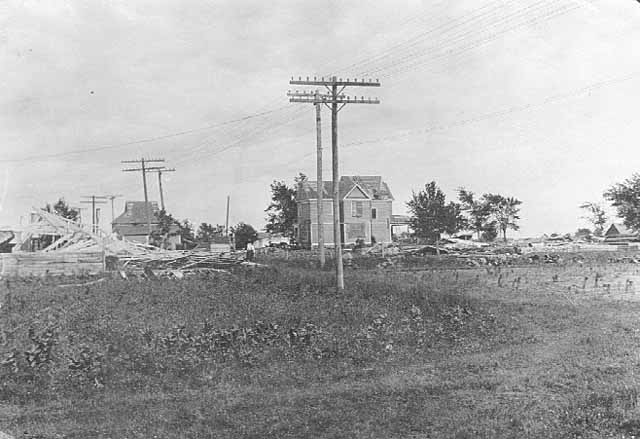
The picture below is the former St. Louis Park Bank building, then the Post Office, also damaged in the 1925 storm. The Minneapolis Journal reported: “There was mail missing in St. Louis Park, Minn. after the storm passed because it blew out the front of the building and scattered letters and papers in all directions.” The building was at present-day Walker Street and Dakota Ave.
An article in the Hennepin County Review dated July 16, 1925, referred to another storm that killed four people in Hennepin County “last week.” The article also reported on a further wind and rain storm that struck early on July 13, 1925, wrecking barns and property in Hopkins and Richfield.
THE DUST BOWL
Although the drought of the 1930s is primarily associated with Oklahoma, Kansas, and Arkansas, the same conditions were present in Minnesota for the better part of two decades. Minnesota farms were subject to drought and heat, rendering them useless. The dry soil blew away, replicating the Dust Bowl further south.
Ken Burns’ documentary explains that during World War I, German blockades cut off the import of Russian wheat, sending the price up to $2/bushel. When the war ended, prices dropped, but farmers expanded their plowing. The original Homestead Act was enlarged, and areas formerly thought to be uninhabitable were cultivated. Prairie grass was turned under by plows that dispersed the soil. For over a decade, there was enough moisture to support the “plow up,” and there were good crops up to and including 1931. The stock market crash brought wheat prices down dramatically, but farmers – including “suitcase farmers” – continued to plow more land, defying the concept of supply and demand.
Then the rains stopped and the winds picked up, creating huge dust storms, particularly in the panhandle of Oklahoma. Crops were ruined, cattle starved, and the people wondered how it came to be. On May 9, 1934, a storm started in Wyoming and moved east, hitting Chicago with 12 million pounds of dirt. By May 11th it had reached the east coast and was seen 300 miles out to sea.
A terrible three-day heat wave hit the country in July 1934, with temperatures in the Twin Cities reaching 105 degrees. 500 people across the country lost their lives; 25 of those were in Minnesota, including Mrs. James Price, 7008 Minnetonka Blvd., St. Louis Park. (Hennepin County Review)
April 16, 1935 was called “Black Sunday” and AP staff writer Robert Geiger coined the term Dust Bowl.
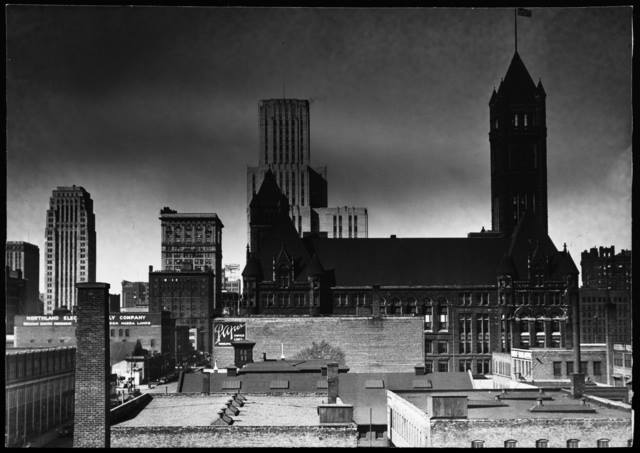
Up in Minnesota, Moorhead registered a record high of 114 degrees on July 6, 1936. It was 104 degrees in the Twin Cities that day. Pity Steele, North Dakota, which clocked in at an astounding 121 degrees.
Some 200,000 people tried to escape to California, only to find low wages and ill treatment. Woody Guthrie’s song “So Long, It’s Been Good to Know Ya” was written about the phenomenon, and John Steinbeck’s novel The Grapes of Wrath was a powerful testament to the hardships that the “Okies” endured. Most of the farmers returned after being disappointed in the Promised Land.
To add insult to injury, winters in the ’30s were especially cold – Bob Jorvig says that it would get to be 30 below and kids would get off school for three days, but then it would STAY at 30 below and the kids had to go to school anyway. In January 1935, the Hennepin County Review reported that the coldest weather in over 30 years struck the area. Temperatures in Minneapolis registered at 32 below, while in Minnetonka some thermometers reached 40 below. The January 24, 1935, headline was “School Excuses Lower Grade Children Yesterday.” (our emphasis) In 1936, temperatures remained below zero for a record thirty-six days beginning on January 18.
And, in Minnesota there was a serious grasshopper plague in June 1932. See above for details of the devastating grasshopper plague of 1873-77.
Eventually the Federal Government persuaded the farmers to practice conservation methods, diversify and limit production, and return vast amounts of land to its natural state. The wheat crop started to make a comeback in 1939. The Dust Bowl was a monumental man-made ecological disaster that had its roots in greed and ignorance.
November 11, 1940, was the date of the Armistice Day Blizzard – a day not to be forgotten by anyone who survived it.
A violent storm on May 28, 1942, caused Minnehaha Creek to overflow. Lightning wreaked havoc on streetcars by shorting out their motors. The 4-inch rain set a record for the month of May.
A freak snowstorm on May 12, 1946, dumped three inches on the Twin Cities.
THE WEATHERBALL
Northwestern National Bank’s Weatherball was inaugurated on October 7, 1949 at 600 Marquette Avenue. Rooftop ceremonies, complete with fireworks, were emceed by WCCO radio’s Cedric Adams. A Mid-Continent Airlines plane carried WCCO’s Bob DeHaven, Aquatennial Queen Jean Johnson, Minneapolis Mayor Eric Hoyer, and members of the City Council Street Lighting Committee. Northwestern Bank president Joseph F. Ringland threw the switch to light up the 157-ft. sign, then the world’s tallest bank sign and the brightest sign of any kind west of Chicago. The 10 ft. Weatherball, 367 ft. above the street, signaled official US Weather Bureau forecasts for the following day. The first rhyme was:
Weatherball as white as snow
Down the temperature will go.
Weatherball as red as fire
Temperature is going higher.
Weatherball an emerald green
Forecast says no change foreseen.
When colors blink in agitation
There’s going to be precipitation.
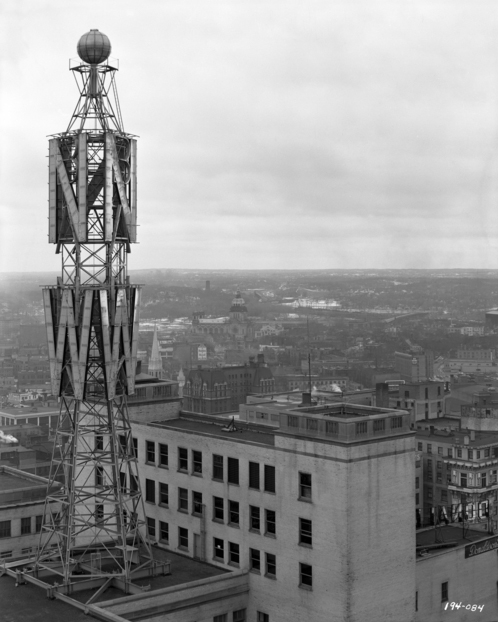
The Weatherball was a beloved Minneapolis landmark until fire destroyed the building on Thanksgiving Day 1982. It was removed in March 1983. There are lots of websites on the Minneapolis icon.
Tremendous winds hit the area on October 10, 1949. The Minneapolis Morning Tribune showed a picture of a 100 ft. metal chimney at National Lead wrapped around the building.
A tornado hit Minneapolis on July 20, 1951. Unknown whether damage was done in St. Louis Park, but this photo is from 50th and Vincent, which isn’t far away.
On January 14, 1952, a horrendous ice storm made the headlines in Minneapolis. That spring, the Mississippi and Minnesota Rivers conspired to cause some of the worst flooding in Minnesota history. The water was 27 ft. high in St. Paul, causing the total destruction and resultant demolition of the West Side Flats.
A rainstorm on May 20, 1960, left waist deep water on Excelsior Blvd. just east of Highway 100.
1965 was a horrible year for weather, with record cold, a terrible blizzard, flooding and tornadoes. See the separate chapter on the Weather of 1965.
On March 22, 1966, eleven inches of snow were dumped on the Cities in 12 hours. Being spring, the snow was wet, and wreaked havoc on power lines.
On June 30, 1967, thunderstorms with hail blown by 100 mph winds destroyed crops to the south, and in the Cities it played with mobile homes, TV towers, and electric lines.
On June 20, 1974, thunderstorms were so thick that the streets went dark – less than one percent of the normal noontime brightness, as calculated at the U of M. Winds tore down branches and trees in an unusual ferocity.
The storm on January 10-12, 1975. was called the “Blizzard of the Century.” One to two feet of snow fell outstate, with 4 inches on top of 9 inches in the Twin Cities. Roads were closed for up to 11 days. Wind gusts reached 70 mph with wind chills down to 70- in SD. The barometer dropped to 28.55” in Duluth, the lowest in Minnesota history.
1977
The schools faced a heating emergency in January 1977 when there were several extremely cold weeks and the school district ran low on money to heat the schools. Winter break was extended, and in an act of extreme cruelty, the temperature of the pools was lowered.
On September 1, 1977, it rained seven inches in four hours. A 100-year rain, they said. Basements flooded, cars stalled, power lines were downed. Luckily the last major section of the city’s storm sewer system had been completed that summer. Still, up on 35th and Wyoming, you could paddle your own canoe. Streets were closed at Highway 100 at Minnetonka Blvd., Dakota Ave., and several spots at Excelsior Blvd. at Highway 100. Minnehaha Creek was up to “parking lot level.” And southern suburbs got it worse. Bloomington got almost eight inches in two hours. Here is footage of 494 and Penn taken the next day, courtesy of Lowell Fideler. Over in St. Paul, the State Fair was flooded. The weather radar screen literally went black, Dave Dahl reported later.
1981
June 14, 1981, was the date of the “Har Mar Tornado,” which also hit Edina and Lake Harriet. Many graduations were taking place that day. Two people died, 100 were hurt.
On November 19, 1981, a blizzard brought heavy snow that collapsed the Metrodome.
1982
A total of 34.3 inches of snow falls on the Twin Cities on January 20 and 22, 1982.
St. Louis Park schools were closed because of ice in about 1982-83.
A killer blizzard on December 28, 1982, socked in the city with 16.5 inches of snow. The snow caved in the Metrodome and similar structures.
1987
On July 23, 1987, a huge rainstorm – actually two thunderstorms that had merged – poured 10 inches of rain on the area in 7 hours. The storm didn’t move, flooding Highways 12 and 494 – cars were floating like boats or completely under water. A retaining wall broke and city workers pulled people from their cars. Highway 12 was closed but people kept trying to get through and some were diving into the water from a railroad bridge. Stores in Southdale were flooded and there was a “puddle” 2-3 ft. deep at Highway 7 and Louisiana. Many power outages resulted, and the rain and high winds closed the airport. Attendees at the Queen of the Lakes Coronation held at International Market Square were “held hostage” by the flooding. See footage from WCCO-TV’s Debbie Ely courtesy of tcmedia now.
1991
An early blizzard on Halloween 1991 caught people off guard and the Cities slowed to a near halt before the tons of snow could be removed. The storm broke many records, including the most single storm snow total (28.4″) and the most snow to fall in a 24 hour period (21). A site with stats on the blizzard is http://climate.umn.edu/doc/journal/top5/numberthree.htm
1994
Governor Arne Carlson first closed schools because of extreme cold on January 18, 1994, as temperatures hit 26 below in the Twin Cities.
1996
Governor Carlson closed schools statewide on February 2, 1996. That’s the day that a state record low was set, according to the Climatology Office, when the air temperature hit minus-60 near the northern Minnesota town of Tower.
1997
Governor Carlson closed schools in response to cold weather on January 16, 1997. Temperatures reached minus-32 in the Twin Cities.
The worst flood in Red River history caused $3.5 billion in damage in 1997.
2011
The EF-1 tornado that devastated North Minneapolis on May 22, 2011, started at the intersection of Highways 394 and 100 in St. Louis Park. Property damaged in the Park included the roofs of the Nestle and ABRA buildings and the Cedar Trails Condos. The Sabes Jewish Community Center offered its building as a makeshift disaster relief center for residents of the condos, which lost power and had a gas leak. See the Public Information Statement of the National Weather Service for all the details of this terrible disaster.
The temperature in the Twin Cities, 103 degrees, was the highest in the entire country on June 7, 2011. Fortunately, the City had just put air conditioning in the Depot!
2013
Torrential rains and 60 mph winds hit the Twin Cities on June 21, 2013, resulting in record power outages. The power was knocked out at two Park water treatment plants, but the city used backup generations to keep the plants working. The area had been battered by one rainstorm after another, making the soil saturated and the trees unstable. The photo below by Emory Anderson is at Nevada Ave. by Northside Park. The lion’s share of the damage was north of Minnetonka Blvd.
2014
In January 2014 schools were closed in the Twin Cities because of the severe cold for and unprecedented five days. The first day was mandated by Governor Dayton for the entire state. Locally the temps that day were -26 in the morning, reaching a high of only -17.
2015
An unusually violent storm blew through the Park on July 18, 2015, causing damage in some parts of town. Below, a utility pole landed on a storage shed on 34th Street between Aquila and Boone Avenues near Aquila Park.
